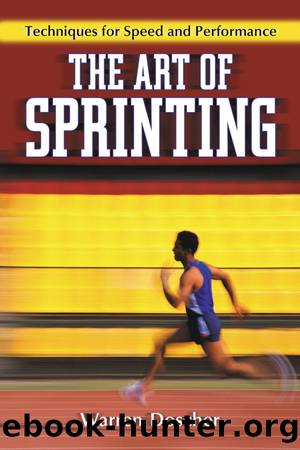The Art of Sprinting by Warren Doscher

Author:Warren Doscher
Language: eng
Format: epub
Tags: General Fiction
Publisher: McFarland
Published: 2012-03-12T16:00:00+00:00
9
THE ARM/LEG CONNECTION
The importance of the role of the arms in the sport of sprinting is, unfortunately, under-appreciated by most of the participants in the sport. It must not be overlooked that the two arms constitute 50 percent of the number of limbs in the runner’s arsenal of moving parts. While the arms do not directly carry the runner down the track, it is believed that the top speed of many runners is limited, not by the ability of their legs, but by the inability of the arms to adequately support the efforts of those legs.
So, the single question is asked, “What is it that the arms can do to assist us in our search for top speed as we race down the track?” And in a single chapter, we will attempt to answer this question. The action of the arms can assist the running effort in two ways: First, the proper use of the arms will increase the stride length obtained by the legs. Second, the proper use of the arms will increase the maximum turnover rate achievable by the legs. Both of these functions are obvious contributors to the running effort. We will, therefore, look at each of them separately.
We begin our study of arm action by looking at those arm motions we can accentuate that will enhance the action of the legs and the consequent stride length. As a starting point, we will conduct some bounding exercises in order to determine what effect different arm actions will have on the stride length produced by the legs. First, perform a bounding sequence with the elbows fully crooked and with a minimum of elbow swing. Note the maximum stride length that can be obtained when there is minimum assistance from the arms. Now, try a second bounding sequence and add a dramatic powerful back swing of the arm. You will probably notice a considerable increase in your stride length. Finally, try a third bounding sequence and remove the exaggerated back swing of the arm. Add, in its place, a strong powerful forward arm swing. You may be surprised to find that your stride length in this sequence is even greater than it was before.
The increase in stride length of the second bounding sequence, when adding the strong back swing, was probably expected and is made possible because the greater rearward arm swing developed greater rearward momentum of the arm. This, in turn, permitted a greater forward carry to the same-side leg, which was in its free-swinging forward motion. On the other hand, when very little arm swing was employed in the first bounding exercise, the lack of arm momentum caused the leg to curtail its forward swing and drop to the ground sooner than it otherwise would. We will look closer at this momentum aspect of the swinging limbs later in this chapter.
Perhaps you found the increase in stride length in the third bounding sequence, when the strong forward arm swing was used, to be a surprise. Let us think about that.
Download
This site does not store any files on its server. We only index and link to content provided by other sites. Please contact the content providers to delete copyright contents if any and email us, we'll remove relevant links or contents immediately.
The Art of Sprinting by Warren Doscher(253)
See Them Run by See Them Run (epub)(240)
The Running Book by John Connell(235)
Focused for Rugby by Adam Nicholls(219)
Running That Doesn't Suck: How to Love Running (Even if You Think You Hate It) by Jhung Lisa(202)
All in a Day's Cricket by Brian Levison(200)
It's Not Cricket by Simon Rae(165)
How to Watch a Game of Rugby by Spiro Zavos(163)
And God Created Cricket by Simon Hughes(160)
County Cricket Ground Quiz Book by Freestone Nigel;(159)
Understanding Cheerleading: Everything you concern about cheerleading like its history, skills, or some facts about cheerleading: Cheerleading Drills by Nicolas Tchikovani(136)
